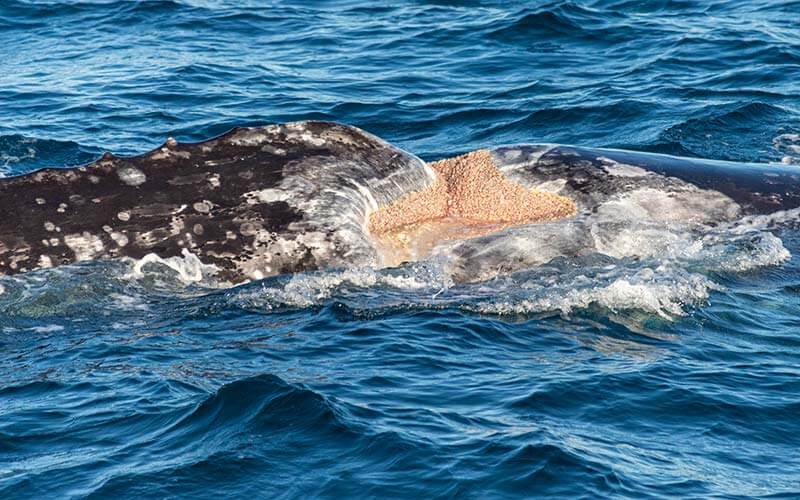Gray Whale Fast Facts
Scientific name: Eschrichtius robustus
Class: Mammalia
Average length: 42 to 49 feet
Average weight: Approximately 90,000 pounds
Average lifespan: Unknown
Cruising speed: 2 to 6 miles, but can go up to 10-11 mph in bursts when in danger
Gestation period: 12 to 13 months
Favorite snack: A savory amphipod quiche with a side of mud pudding
Favorite tunes: Strictly musicals and show tunes
Favorite pastime: Deep sea bingo
Best time to see gray whales in southern California: December through May
Gray Whales: Dive Deeper
What do you call a 40 to 50-foot lice covered, barnacle-encrusted, mud sucking, bottom feeder?
Whale, here at Captain Dave’s we are referring to some of our most favorite and friendly pals, the gray whales!
Gray Whale Migration
North Pacific Gray whales have one of the longest migration routes of any marine mammal. In the fall they begin their roughly 12,000-mile round trip migration from their summer feeding frenzy in the Arctic waters of the Bering and Chukchi Seas, and head south along the U.S. west coast to the warm lagoons of Baja California, Mexico. There the whales mate and give birth to their calves. When they’re born gray whale calves are about 15 feet long and will gain over 50 pounds a day feeding on mother’s milk, which is 50% fat. In comparison, human milk is only about 3% to 5% fat.
The whales will spend several weeks in the protected lagoons. From about mid-February through May, they’ll make the long journey back north along the west coast of the U.S. to the Arctic. New mothers linger the longest to give their calves time to increase their layer of blubber.
As these slow-moving, gentle, animals glide through the nutrient-rich ocean waters, their cuddle-hungry friends, the barnacles, have an opportunity to get comfy and cozy on their large 40-50 foot, 90,000-pound body. These barnacles then play host to the lovely lice that hop on board these mottled gray creatures and hitchhike their way across the deep blue.
A small subset of eastern North Pacific gray whales does not migrate all the way back to the waters north of Alaska. This population of about 200 animals, known as the Pacific Coast Feeding Group, remain off the coast of Oregon and the Pacific Northwest to feed between the months of June and November, and are considered part-time residents. Of those part-time residents, only 40 are considered residents because they return year after year and hang out for a least a couple of days while feeding.
A study published in February 2019 in The Journal of Wildlife Management by Oregon State University’s Marine Mammal Institute discovered that those part-time residents had a home range from northern California to southern Alaska. And most of them traveled to the Baja lagoons during winter to breed.
Using satellite tags, the study looked at the movements of 35 gray whales off the coasts of Oregon and northern California during a period of three years. Researchers found that at least one whale is truly a “resident” and remained off the coasts of northern California and central Oregon for over a year. Whereas another gray whale traversed an area of about 8,500 square miles.
Researchers still don’t know why this small subset of gray whales does not migrate to the Arctic. They theorize that it’s possible the whales are finding enough food in the Pacific Northwest to sustain them. They believe it’s also possible that part-time residents have not increased in numbers because the food supply cannot feed a bigger population of whales.
Meet Gray Whale “Scarback”

Scarback is a well-known female gray whale with a massive scar believed to be caused by an exploding harpoon. She is also one of the seasonal residents who spends her summers feeding off the coast of Oregon instead of heading up to the Arctic.
Scarback has been seen off the central coast of Oregon since 1979 and is easily identified by the huge scar on her right dorsal hump. Biologists believe she acquired the lice-ridden scar from a harpoon between 1985 and 1987.

The lice, which look pinkish-orange, actually help the whale by feeding on dead and decaying tissue. Despite her serious injury Scarback is doing well and remains friendly towards boats.
Marine Biologist Carrie Newell has witnessed Scarback with at least five calves and believes Scarback to be in her 40’s. Scarback is also a well known ‘cougar’ – she enjoys mating with younger males.
What Does a Gray Whale Eat?
Gray whales are baleen whales that feed primarily on small crustaceans called amphipods. They don’t typically catch their food in the water column like blue whales or humpback whales. Instead, a gray whale dives to the bottom, rolls on its side and scoops up a mouthful of mud. The whale closes its mouth and pushes out the water and bottom sediment through baleen plates that hang from the whale’s upper jaw, leaving behind the amphipods to swallow. YUM!
Their feasting adventures in the Bering and Chukchi Seas are all in preparation for their five-month-long fast, which begins shortly after their departure from the summer feeding grounds in cold Alaskan waters. There is very little of their preferred food south of Oregon. And you thought the time between lunch and dinner made ya hangry?
Although gray whales are known for being bottom feeders, they’re also known for taking advantage of an opportunity to sample some of the local cuisine in Southern California and other areas off the U.S. west coast. They’ll eat krill or pelagic crabs in the water column or look for food in kelp forests.
Gray Whale Population
Commercial whaling operations between the mid-1800s and early 1900s decimated gray whale populations and brought the animals to the brink of extinction. A preference for shallow waters near the coast and the calving lagoons in Baja California, Mexico, made gray whales an easy target for whalers, who used the whale blubber to make oil that was used in lamps. Based on genetic research, pre-whaling population estimates range from 76,000 to 118,000 individuals throughout the Northern Hemisphere.
As a result of whaling, gray whales now only exist in the eastern North Pacific ocean (along the U.S. west coast) and western North Pacific (along the coast of eastern Asia). Gray whales that once inhabited the Atlantic Ocean are extinct.
Thanks to conservation measures in the 1930s and 1940s, and the International Whaling Commission’s moratorium on commercial whaling in the 80s, the current population of eastern North Pacific gray whales is estimated at 20,000 individuals. That stock was removed from the U.S. Endangered Species List in 1994. However, the western North Pacific population is estimated at only around 200 individuals and remains listed as ‘endangered’ under the Endangered Species Act.
Threats to Gray Whales
In addition to their lack of food, gray whales face several other challenges. Their main non-human threat comes from orcas. These gentle giants often fall prey to killer whales, and according to N.O.A.A. estimates, up to 35% of gray whale calves may be preyed on by killer whales.
Gray whales are also vulnerable to ship strikes. The International Whaling Commission continues to collect and analyze data about reported ship strikes to identify “hot spots” and reduce future collisions.
Another threat is one that takes the lives of nearly 1,000 whales and dolphins every day. Scientists estimate that every year, 308,000 dolphins and whales worldwide die because of entanglement in fishing gear.
Our very own Captain Dave is all too familiar with this marine wildlife catastrophe and organized Orange County’s first whale disentanglement group in 2008. He has successfully disentangled several gray whales. One very well known rescue, both in Southern California and nationwide, is that of “Lily”.
Lily, whose disentanglement made national headlines when she stranded herself inside Dana Point Harbor, drew crowds from near and far, winning the hearts of onlookers across the country. Her amazing story left a deep impact on Capt. Dave, who soon after Lily’s passing, authored the award-winning book, Lily, A Gray Whale’s Odyssey, a magnificent photographic journey of a gray whale’s migration. Capt. Dave has also launched his largest catamaran, “Lily Whale Research/Rescue Safari”, a 62-foot luxury whale watching vessel that has been specially equipped to rescue entangled whales and dolphins.
Although the story of Lily’s experience is one that will leave you wanting to join Greenpeace, and bow out on eating fish and chips, these amazing animals don’t all end up as she did. In fact, these beautiful bottom feeders are frequent flyers on our whale watching safari’s during their annual migration, and love to get up close and personal with our vessels and passengers, no strings attached! It’s not uncommon to find these 30 to 40-ton animals breaching or spy-hopping just outside of Dana Point Harbor in their effort to take a look around and get their bearings.
We have the amazing opportunity to encounter these barnacle bejeweled buddies, between the months of December through May, as they are trekking along on their annual migration. We occasional see gray whales as early as November, and as late as July, and love their visits so much that every March, Dana Point celebrates the gray whale migration with the Festival of Whales. The Dana Point Festival of Whales began nearly 50 years ago as an annual community event and now attracts nearly 100,000 visits each year. Residents and visitors celebrate migrating gray whales and other marine wildlife with ocean-themed activities and presentations emphasizing education and environmental responsibility.
So, if you’re in the mood to get comfy and cozy with these gray gals and guys, come on-board with us during one of our daily whale watching adventures, where we’ll get you as close as possible to these friendly, gentle, and oh so unique creatures. We won’t be able to get you as close as the barnacles are, but we’ll sure try our best to provide you with the most unforgettable and intimate experience out there, minus the lovely lice.
And hey, you may even have one pop up and sneak a peek at ya, or wave hello!
So, if you’re in the mood to get comfy and cozy with these gray gals and guys, come on-board with us during one of our daily whale watching adventures, where we’ll get you as close as possible to these friendly, gentle, and oh so unique creatures. We won’t be able to get you as close as the barnacles are, but we’ll sure try our best to provide you with the most unforgettable and intimate experience out there, minus the lovely lice.
And hey, you may even have one pop up and sneak a peek at ya, or wave hello!
